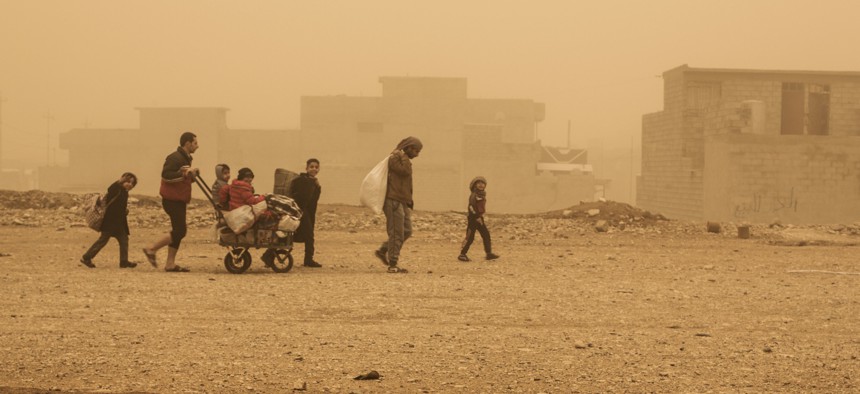
A group of civilians pass close to the body of an Islamic State militant, while fleeing from Mosul due to ISIS heavy shelling in several areas under control of the Iraqi Army, Mosul, Iraq, Friday, Dec. 2, 2016. Manu Brabo/AP
US Counterterrorism Strategy Must Be About More than ISIS
Even as Trump focuses on the Islamic State, other dangerous groups need attention.
As he promised on the campaign trail, President Donald Trump has moved quickly against the Islamic State, directing the Joint Chiefs of Staff to develop an aggressive plan to defeat the group and temporarily banning citizens from seven Muslim-majority countries from entering the U.S. Critics of the ban believe it will actually weaken domestic counterterrorism efforts and bolster Islamic State propaganda and recruitment. But there is another glaring hole in this strategy as it is currently comprised: it fails to address another half-dozen or so other terrorist groups throughout the world that threaten American security and global order.
The Islamic State is certainly a worthy candidate for eradication, but failing to similarly also target its franchises, al-Qaida splinters, and other non-aligned groups in the Middle East, Africa, and South Asia could allow other threats to metastasize. This could lead to a situation similar to one that happened in the mid-2000s, when the Bush administration diverted military and intelligence resources to Iraq, enabling the Taliban to reassert itself in Afghanistan.
Although Western policymakers — and the news media — tend to focus on the core of the Islamic State in Syria and Iraq, the group has dispersed to various failed states and ungoverned spaces where they have gained traction with local militant groups. In 2016 alone, it directed or inspired a spate of attacks worldwide, from Brussels to Nice, Dhaka, Istanbul, and beyond. The Christmas market attack in Berlin was recently traced to Islamic State external operations planners in Libya.
In south Asia, the Islamic State’s Khorasan group is active, although largely contained. Islamic State affiliates in Egypt’s Sinai Peninsula have struck Russian and other targets. In Libya, the group has lost territory in and around Sirte, but is nevertheless taking advantage of the power vacuum that inevitably follows internecine civil wars. In Nigeria, the Islamic State has forged a partnership with Boko Haram, although this alliance has so far proven less potent than expected.
Meanwhile, al-Qaida is also quietly and patiently rebuilding its organization. Despite the diminuation of its core base in Pakistan, its affiliates remain dangerous. There is al-Qaida in the Indian subcontinent and the guerrilla insurgents of the Haqqani network in Afghanistan. In north and west Africa, Al-Qaida in the Islamic Maghreb launched over 100 attacks in in 2016. Mali, in particular, remains a haven for various al-Qaida-linked jihadist groups. In east Africa, al-Shabaab continues to wreak havoc throughout the Horn of Africa despite an onslaught by the U.S.-backed African Union Mission to Somalia. And the Yemen-based Al-Qaida in the Arabian Peninsula continues to be a highly capable adversary intent on striking the United States.
In Syria, the Nusra Front (rebranded Jabhat Fateh al-Sham) is consolidating territory and working to enmesh itself within the broader Syrian opposition. Because of the focus on the Islamic State, Jabhat Fateh al-Sham has been left with room to operate, all the while portraying itself as a moderate alternative to some of the more hardcore Salafist groups on the ground.
In Afghanistan, the Taliban is gaining ground. It has demonstrated its potency through a string of spectacular attacks in major cities. And although it has primarily been conducting operations in Syria, Hezbollah retains the ability to conduct strikes globally and regularly expresses anti-American and anti-Israeli sentiments.
Toward a Broader Counterterrorism Policy
Clearly, focusing solely or even primarily on the Islamic State’s operations in Syria and Iraq would be a mistake that would almost certainly guarantee the expansion of other groups. Here are a few options for the Trump administration to consider.
At the moment, the United States is on the outside looking in on Syrian peace talks. Russia, Turkey and Iran have the lead in the talks, which are being held in Kazakhstan and are aimed at ending the conflict through political settlement. If the United States were to join the discussions, it could attenuate the conflict and help to ratchet down violence in the short term.
As the Islamic State is weakened, the Trump administration should expect and prepare for spillover violence to occur in Syria’s neighboring states. It should also expect to see an increase in activity in places where the Islamic State has a foothold, or where other terrorist organizations maintain bases of operations. In a worst-case scenario, Islamic State splinter groups would link up with al-Qaida elements in countries such as Yemen, Afghanistan and Syria.
In addition, the U.S. should continue to expand its use of unmanned aerial systems and special operations forces for surveillance and targeting purposes. Maintaining awareness of on-the-ground conditions in areas where terrorist groups operate will allow the United States to respond to threats as they manifest. This will translate into more raids similar to the one in early January in which American commandos killed an Islamic State leader in eastern Syria and into operations akin to the airstrikes that killed over 100 al-Qaida fighters in western Syria later in the month.
Finally, the U.S. should vigorously promote cooperation with states where these terrorist organizations are active. This can start by building the partner capacity of weak states and working to improve their governance, reform ministries and institutions.
While President Trump may be eager to win the war on the Islamic State, he and his administration must remember that tangible and enduring improvement in U.S. national security will require patience and a broader view.



